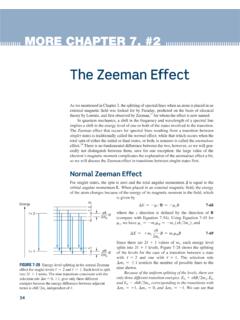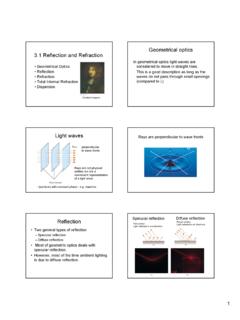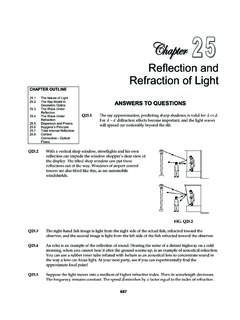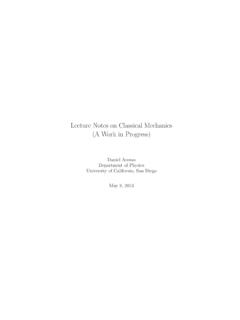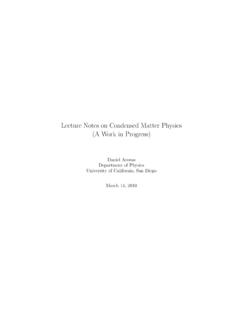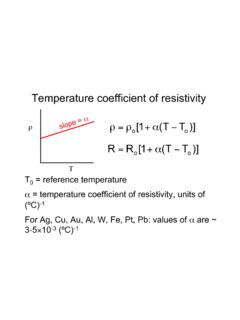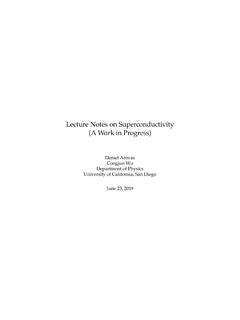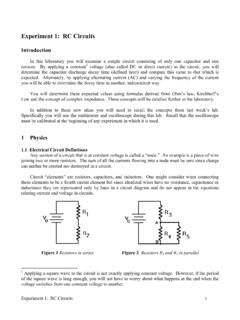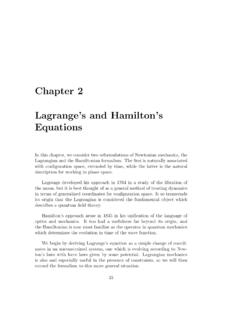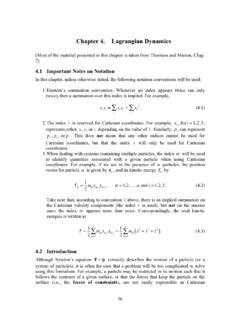Transcription of Lagrangian Mechanics - Physics Courses
1 chapter 6 Lagrangian Generalized CoordinatesA set ofgeneralized coordinatesq1, .. , qncompletely describes the positions of all particlesin a mechanical system. In a system withdfdegrees of freedom andkconstraints,n=df kindependent generalized coordinates are needed to completely specify all the positions. Aconstraint is a relation among coordinates, such asx2+y2+z2=a2for a particle movingon a sphere of radiusa. In this case,df= 3 andk= 1. In this case, we could eliminatezin favor ofxandy, writingz= a2 x2 y2, or we could choose as coordinatesthe polar and azimuthal angles and .For the moment we will assume thatn=df k, and that the generalized coordinates areindependent, satisfying no additional constraints among them.
2 Later on we will learn howto deal with any remaining constraints among the{q1, .. , qn}.The generalized coordinates may have units of length, or angle, or perhaps something totallydifferent. In the theory of small oscillations, the normal coordinates are conventionallychosen to have units of (mass)1/2 (length). However, once a choice of generalized coordinateis made, with a concomitant set of units, the units of the conjugate momentum and forceare determined:[p ]=M L2T 1[q ],[F ]=M L2T2 1[q ],( )where[A]means the units ofA , and whereM,L, andTstand for mass, length, and time,respectively. Thus, ifq has dimensions of length, thenp has dimensions of momentumandF has dimensions of force.
3 Ifq is dimensionless, as is the case for an angle,p hasdimensions of angular momentum (M L2/T) andF has dimensions of torque (M L2/T2).12 chapter 6. Lagrangian hamilton s PrincipleThe equations of motion of classical Mechanics are embodiedin a variational principle,calledHamilton s s principle states that the motion of a system is suchthat theaction functionalS[q(t)]=t2 t1dt L(q, q, t)( )is an extremum, S= 0. Here,q={q1, .. , qn}is a complete set ofgeneralizedcoordinatesfor our mechanical system, andL=T U( )is theLagrangian, whereTis the kinetic energy andUis the potential energy. Setting thefirst variation of the action to zero gives the Euler-Lagrange equations ,ddtmomentump ( L q )=forceF L q.
4 ( )Thus, we have the familiar p =F , also known as Newton s second law. Note, however,that the{q }aregeneralized coordinates, sop may not have dimensions of momentum,norF of force. For example, if the generalized coordinate in question is an angle , thenthe corresponding generalized momentum is the angular momentum about the axis of srotation, and the generalized force is the Invariance of the equations of motionSuppose L(q, q, t) =L(q, q, t) +ddtG(q, t).( )Then S[q(t)] =S[q(t)] +G(qb, tb) G(qa, ta).( )Since the difference S Sis a function only of the endpoint values{qa, qb}, their variationsare identical: S= S. This means thatLand Lresult in the same equations of , the equations of motion are invariant under a shift ofLby a total time derivative ofa function of coordinates and Remarks on the order of the equations of motionThe equations of motion are second order in time.
5 This follows from the fact thatL=L(q, q, t). Using the chain rule,ddt( L q )= 2L q q q + 2L q q q + 2L q t.( ) hamilton S PRINCIPLE3 That the equations are second order in time can be regarded asan empirical fact. It follows,as we have just seen, from the fact thatLdepends onqand on q, but on no higher timederivative terms. Suppose the Lagrangian did depend on the generalized accelerations qaswell. What would the equations of motion look like?Taking the variation ofS, tb tadt L(q, q, q, t) =[ L q q + L q q ddt( L q ) q ]tbta+tb tadt{ L q ddt( L q )+d2dt2( L q )} q .( )The boundary term vanishes if we require q (ta) = q (tb) = q (ta) = q (tb) = 0.
6 The equations of motion would then befourth orderin Lagrangian for a free particleFor a free particle, we can use Cartesian coordinates for each particle as our system ofgeneralized coordinates. For a single particle, the LagrangianL(x,v, t) must be a functionsolely ofv2. This is because homogeneity with respect to space and time preclude anydependence ofLonxor ont, and isotropy of space meansLmust depend onv2. Wenext invoke Galilean relativity, which says that the equations of motion are invariant undertransformation to a reference frame moving with constant velocity. LetVbe the velocityof the new reference frameK relative to our initial reference frameK.
7 Thenx =x Vt,andv =v V. In order that the equations of motion be invariant under thechange inreference frame, we demandL (v ) =L(v) +ddtG(x, t).( )The only possibility isL=12mv2, where the constantmis the mass of the particle. Note:L =12m(v V)2=12mv2+ddt(12mV2t mV x)=L+dGdt.( )ForNinteracting particles,L=12N a=1ma(dxadt)2 U({xa},{ xa}).( )Here,Uis thepotential energy. Generally,Uis of the formU= aU1(xa) + a<a v(xa xa ),( )4 chapter 6. Lagrangian Mechanics however, as we shall see, velocity-dependent potentials appear in the case of charged parti-cles interacting with electromagnetic fields. In general, though,L=T U ,( )whereTis the kinetic energy, andUis the potential Conserved QuantitiesA conserved quantity (q, q, t) is one which does not vary throughout the motion of thesystem.
8 This meansd dt q=q(t)= 0.( )We shall discuss conserved quantities in detail in the chapter on Noether s Theorem, Momentum conservationThe simplest case of a conserved quantity occurs when the Lagrangian does not explicitlydepend on one or more of the generalized coordinates, = L q = 0.( )We then say thatLiscyclicin the coordinateq . In this case, the Euler-Lagrange equations p =F say that the conjugate momentump is conserved. Consider, for example, themotion of a particle of massmnear the surface of the earth. Let (x, y) be coordinatesparallel to the surface andzthe height. We then haveT=12m( x2+ y2+ z2)( )U=mgz( )L=T U=12m( x2+ y2+ z2) mgz.
9 ( )SinceFx= L x= 0 andFy= L y= 0,( )we have thatpxandpyare conserved, withpx= L x=m x , py= L y=m y .( )These first order equations can be integrated to yieldx(t) =x(0) +pxmt , y(t) =y(0) +pymt .( ) CONSERVED QUANTITIES5 Thezequation is of course pz=m z= mg=Fz,( )with solutionz(t) =z(0) + z(0)t 12gt2.( )As another example, consider a particle moving in the (x, y) plane under the influence ofa potentialU(x, y) =U( x2+y2)which depends only on the particle s distance fromthe origin = x2+y2. The Lagrangian , expressed in two-dimensional polar coordinates( , ), isL=12m( 2+ 2 2) U( ).( )We see thatLis cyclic in the angle , hencep = L =m 2 ( )is is the angular momentum of the particle about the zaxis.
10 In the languageof the calculus of variations, momentum conservation is what follows when the integrand ofa functional is independent of theindependent Energy conservationWhen the integrand of a functional is independent of thedependentvariable, another con-servation law follows. For Lagrangian Mechanics , considerthe expressionH(q, q, t) =n =1p q L .( )Now we take the total time derivative of H:dHdt=n =1{p q + p q L q q L q q } L t.( )We evaluate Halong the motion of the system, which entails that the terms in the curlybrackets above cancel for each :p = L q , p = L q .( )Thus, we finddHdt= L t,( )which means thatHis conservedwhenever the Lagrangian contains no explicit time depen-dence.
